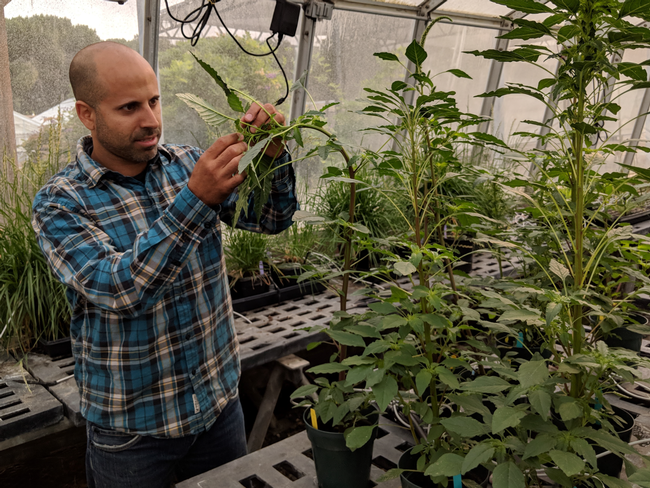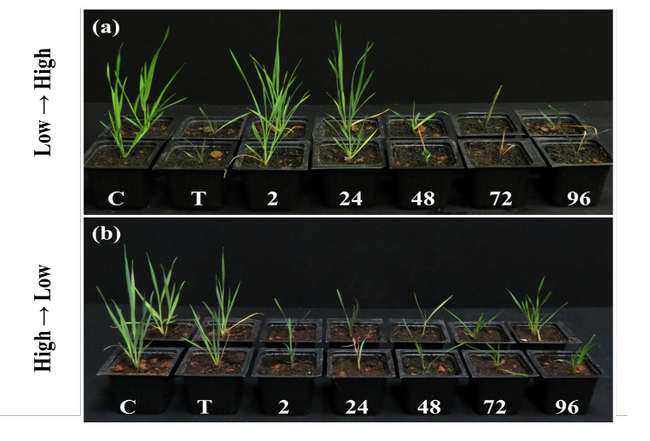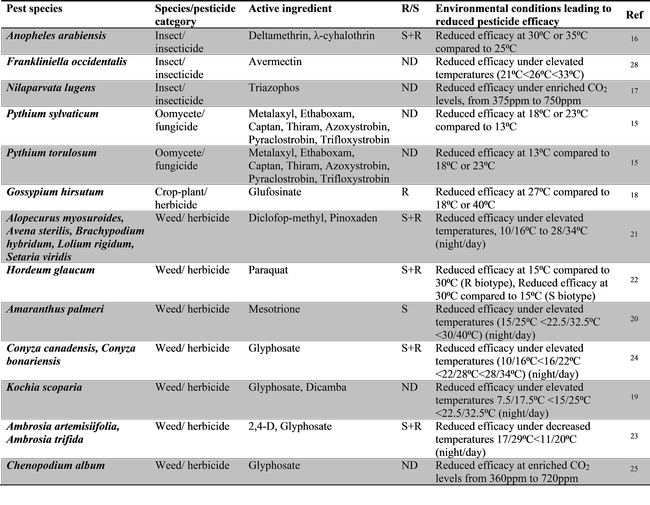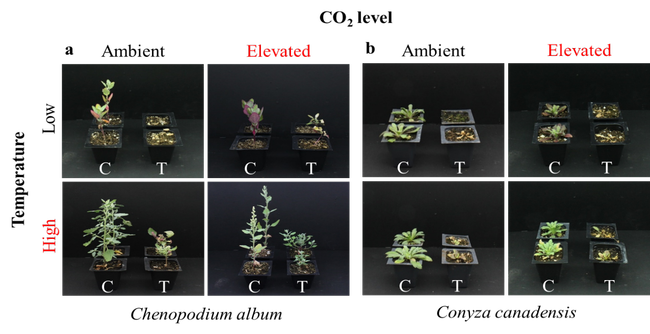
Maor Matzrafi is a post-doctoral researcher with Marie Jasieniuk's lab at UC Davis.
It is well known that herbicide efficacy is strongly associated with environmental conditions (Kudsk and Kristensen, 1992), and this is why applicators are required (by law) to spray under specific environmental conditions. In recent years, we have witnessed an increase in extreme weather events that have emphasized the importance of maintaining proper environmental conditions at, but more importantly after herbicide application. As part of my PhD project, I demonstrated that the first 48 hours after treatment (HAT) with pinoxaden (Axial®,45 g L-1 EC, Syngenta, Switzerland) can have a major impact on the success of weed control (Matzrafi et al., 2016). To begin with, pinoxaden-treated Brachypodium hybridum plants showed low survival rates when grown under low temperature and reduced pinoxaden sensitivity when grown under high temperature [Fig. 1, control (C) and treated plants (T)]. When pinoxaden-treated plants were transferred from low- to high-temperature at or before 48 HAT, high survival rates were recorded. Plants that were transferred from high- to low- temperature after more than 48 HAT maintained the temperature-dependent response that they had acquired while subjected to their original growth temperature (Fig. 1 a, b).
Figure 1. Temperature-dependent response of B. hybridum plants to pinoxaden at different time points after herbicide application. Plants were grown under low (16/10°C, day/night, (a) and high [(34/28 °C, (b)] temperatures. Following the application of pinoxaden, plants were transferred to the opposite temperature at 2, 24, 48, 72, and 96 hours after treatment (HAT; C control, T pinoxaden). Photos were taken 21 days after treatment. Shoot fresh weight was measured at 21 days after treatment (c). From Matzrafi et al., 2016.
With this work, I showed not only the temperature but the time the treated-plant spent in that temperature is important for its survival. If we assume that the window of opportunity for herbicide effectiveness is 24-96 HAT, we can predict that the same temperature/time-dependent herbicide sensitivity shown in B. hybridum, will be observed in other species treated under unfavorable environmental conditions.
Several cases of reduced pesticide sensitivity under unfavorable environmental conditions have been previously documented. In general, increased temperatures and elevated CO2 levels are shown to reduce herbicide efficacy, but the opposite trend has also been recorded (Table 1). For both paraquat and glyphosate, reduced sensitivity was observed under either low or high temperatures. In these cases, the differences in environmental-dependent herbicide response seems to be either species or biotypes (R/S) specific, but additional work is required to better understand the mechanism underlying this environmental-dependent herbicide response (Matzrafi, 2018). This trend of reduced pesticide sensitivity under unfavorable environmental conditions is adding to the growing concern over the potential negative impacts of global climate change on pest management (Ziska and McConnell, 2016).
Table 1. Documented reports of variation in pesticide sensitivity under changing environmental conditions. From Matzrafi, 2018.
R/S – refers to the previously categorized pesticide phenotype of the tested biotype as it was specified in the cited study.
ND – not documented.
In a recent study conducted in the Jasieniuk lab at UC Davis, we tested two annual weed species, Conyza canadensis (horseweed) and Chenopodium album (common lambsquarters), for their response to glyphosate under different environmental conditions. Glyphosate-treated plants were grown under different temperature regimes [control (18/12°C) and future predicted maximum temperatures (32/26°C)] combined with two CO2 levels [ambient (~400ppm) and enriched CO2 levels (720ppm)].
Reduced glyphosate sensitivity, as measured by plant mortality, was found in both C. canadensis and C. album in response to elevated temperatures, enriched CO2 levels and the combination of both treatments (Fig. 2). The combination of both environmental factors resulted in higher survival rates compared to the effect of each factor alone. Moreover, loss of apical dominance and early initiation of reproductive structures were observed in glyphosate-treated plants grown under high temperature combined with elevated CO2 level (Fig. 2a).
Figure 2. Plant response to glyphosate under different environmental conditions. Glyphosate-treated (T) and untreated (C) plants of C. album (a) and C. canadensis (b) grown under different temperatures and CO2 levels at 21 days after treatment. Low = (18/12°C), high = (32/26°C), ambient = ~400ppm and elevated = 720ppm.
Our study, as well as the work of others in this field, highlights the importance of maintaining proper environmental conditions after herbicide application. The findings suggest that applicators should adopt an approach which takes under consideration the environmental conditions both at and after herbicide application. Of course, not all herbicide treatments can be applied at the optimal time but understanding that maintaining sprayed plants under unfavorable environmental conditions may lead to reduced herbicide sensitivity is crucial for the success of herbicide application. Additional information, on the herbicide label, stating the optimal temperature range recommended after herbicide application may help to reduce future weed control failures.
References
Kudsk, P. and Kristensen, J. (1992). Effect of environmental factors on herbicide performance. in Proceedings of the first international weed Control Congress,Melbourne. 173–186.
Matzrafi, M. (2018). Climate change exacerbates pest damage through reduced pesticide efficacy. Pest Manag. Sci. DOI:10.1002/ps.5121.
Matzrafi, M., Seiwert, B., Reemtsma, T., Rubin, B. and Peleg, Z. (2016). Climate change increases the risk of herbicide-resistant weeds due to enhanced detoxification. Planta 244, 1217–1227.
Ziska, L. H. and McConnell, L. L. (2016). Climate change, carbon dioxide, and pest biology: monitor, mitigate, manage. J. Agric. Food Chem. 64, 6–12.


